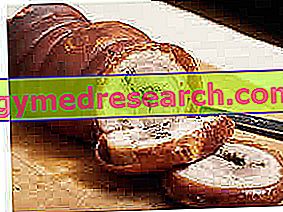Etymology and History
Porchetta derives from the Latin " porchetti ", in Italian "porchetto", or small pig.

- the first, to which we will refer in the next paragraphs, is used to name a young pig roast, gutted, boned, scraped by the hair, with the head, seasoned, impaled, tied (sewn) and cooked so as to give crispiness to the rind external;
- the second indicates the young specimen of Sus scrofa domesticus (pig); in fact, it is not uncommon for a small pig (often still from milk) to be called porchetta directly, as this is the favorite cooking for this type of beef.
- the third meaning, used in central Italy (in the same areas in which the pork roast was born and is still consumed), indicates any preparation flavored with wild fennel or seeds or dried flowers of the same plant; a classic example is the "porchetta rabbit" (hence also the term "porchettare").
It is conceivable that porchetta is a recipe of Central Italian origin, more precisely from the area of Ariccia (just south of the capital), where the well-known Vallericcia crater opens. Here, in the culture of the assisi, the goddess Cerere was worshiped (a subsoil divinity linked to the fertility of the earth, from which the name "cereals" was extrapolated); following the development of Roman culture (influenced by Greek culture), Ceres became Demeter and, in the same places, temples were built in honor of Maia (always of Ionian origin, spring goddess, mother and wife of Vulcan, and symbol of fertility) . At the beginning of the 20th century, with the discovery of various finds, some statues were found depicting the sacrifice of small pigs (porchette) in Ceres, and of large pregnant sows in Maia (which gave its name to the very common "pig") .
Ariccia was therefore the main site of the breeding of sacrificial pigs, offered about a week old in the temple of Casaletto. Not surprisingly, since 1950, in the month of September at the square of Corte Ariccia we celebrate the "Sagra della Porchetta", which, today, makes use of the label of Typical Geographical Indication (IGP).
To learn more: Porchetta di Ariccia »
What is Porchetta
As anticipated, the porchetta is a dish cooked in the oven. It is a roasted suckling pig (if small, some cook it on a spit), previously gutted, boned, without hair on the rind, seasoned, impaled and tied (sewn).
In theory, porchetta should NOT be more than a year (<90-100kg) BUT it should not even be "dairy" (4-5kg); probably the ideal size is around 30-40kg.
What distinguishes the various porchette (Lazio, Umbria, Abruzzo, Marche, Romagna etc.) is the mixture used for the dressing, whose basic components are: coarse salt, black pepper, fennel (or seeds or flowers), jacketed garlic, rosemary, liver and spleen (the latter ground); more or less optional wine and olive oil.
Baking takes place in the oven (once fed with wood), but there are variations more similar to the "porceddu sardo", to the "spiedo Sloveno" or to the Sicilian "porceddu sutta terra".
The porchetta can be eaten hot, cold, in sandwiches or in various preparations such as first courses or complex dishes. What distinguishes a good roast from a poor or poorly preserved one is the consistency of the rind; this, while accompanying a soft meat and fat, must be crunchy like a biscuit.
Nutritional Features
Porchetta is a very energetic food. Calories are essentially provided by fats and proteins (with a high biological value). Carbohydrates are absent, as is dietary fiber.
Many believe that its rind is a portion rich in lipids; on the contrary, it is a collagenous surface which, in itself, contains mainly proteins. However, below it, there is an evident layer of adipose tissue (extremely fat). It is no coincidence that cholesterol intake is also quite high.
As far as vitamins are concerned, porchetta is rich in niacin (vit. PP) and, more generally, in many others in group B; the retinol is not missing (vit. A). With regard to minerals instead, the food is abundant in iron, potassium and sodium.
Due to the very high energy intake, the roast pork is a strongly inadvisable food in case of overweight and does not lend itself to the low-calorie slimming diet. At the same time, the fats contained in it have a relationship between saturated and unsaturated medium. The fraction of the saturated ones should be equivalent (more or less) to that of monounsaturated ones; on the other hand, separate report, the absolute share of saturated fatty acids is still very high and this (in association with the generous content of cholesterol) makes it less advisable in case of hypercholesterolemia. Finally, the high sodium content (which often abounds to increase its conservation) also excludes it from the hypertensive subject's diet.
The average portion of porchetta ranges between 100 and 200g, depending on the cut; the frequency of consumption must however be sporadic.



